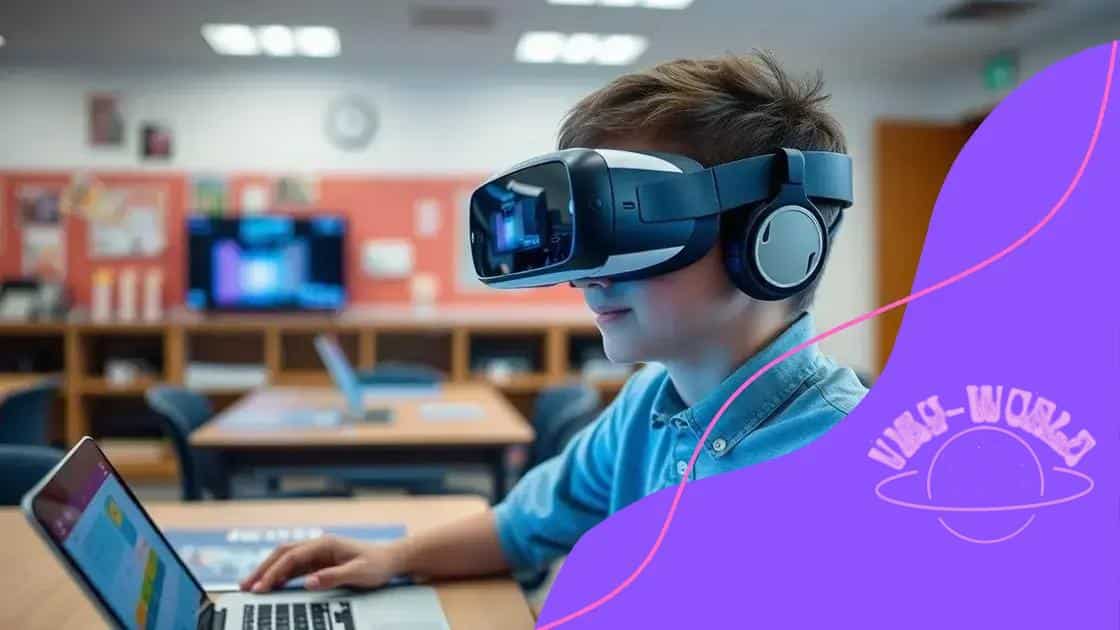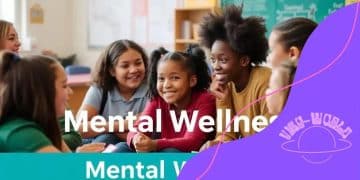Virtual reality in STEM education: enhancing learning

Virtual reality in STEM education enhances learning by providing immersive experiences, fosters engagement, promotes collaboration, and allows for personalized educational opportunities that strengthen understanding of complex concepts.
Virtual reality in STEM education opens up a world of possibilities, making complex concepts more accessible and engaging. Have you ever wondered how immersive technologies can transform traditional learning? Let’s explore this exciting intersection.
Understanding virtual reality in education
Understanding virtual reality in education is essential for grasping its impact on learning. This innovative technology is changing how educators and students interact with subject matter. By creating immersive environments, virtual reality allows learners to engage with concepts in ways they never thought possible.
This technology introduces new dimensions to education. Imagine walking on Mars while learning about space science or diving into the ocean to study marine biology. Such experiences are not only memorable but also enhance information retention.
Key Features of Virtual Reality in Education
When integrating virtual reality into learning, several features stand out:
- Immersive learning experiences
- Enhanced motivation and engagement
- Safe environments for practice
- Individualized learning paths
Moreover, virtual reality can address various learning styles. Visual learners benefit greatly from seeing concepts in action, while kinesthetic learners thrive in interactive environments. All types of students can find ways to connect with the material.
This technology also fosters collaboration. Students can work together in a shared virtual space, regardless of their physical location. Whether they’re building a virtual city or exploring historical sites, students forge connections and learn team dynamics.
Nevertheless, adapting to virtual reality comes with some challenges. Schools need the right equipment and resources to create effective VR programs. Additionally, teachers may require training to utilize this technology efficiently. However, the potential benefits outweigh these obstacles.
Ultimately, understanding virtual reality in education opens doors to new possibilities. As we embrace this technology, we will likely discover even more ways to enhance the learning experience.
Benefits of virtual reality in STEM fields
The benefits of virtual reality in STEM fields are numerous and impactful. This technology not only enhances traditional learning methods but also opens up new opportunities for engagement and exploration.
One key advantage is increased engagement. Students are more likely to participate actively when they can explore immersive worlds. For example, a chemistry class can transform into a virtual lab where students conduct experiments without the risks associated with real chemicals.
Enhanced Understanding of Complex Concepts
Virtual reality helps students grasp intricate concepts by providing visual and interactive experiences. Instead of reading about the solar system, learners can navigate through space, witnessing planetary movements firsthand.
- Practical experience without physical risks
- Visualization of abstract concepts
- Immediate feedback in simulated environments
- Greater retention of knowledge
Furthermore, virtual reality encourages collaboration among students. In a shared virtual environment, learners can work together on projects, enhancing their teamwork skills. This can simulate real-world situations where group collaboration is critical.
Another significant benefit is accessibility. With VR, students from various backgrounds can experience the same high-quality education, regardless of their physical location. This democratizes learning, making it more inclusive.
Teachers also benefit from using virtual reality. They can create customized lessons tailored to their students’ needs, allowing for differentiated instruction. VR tools can facilitate personalized learning paths, catering to different paces and styles.
In summary, the use of virtual reality in STEM fields offers a multitude of advantages, from boosting student engagement to improving understanding and collaboration. The potential for innovation and enhanced learning experiences is vast, paving the way for future generations.
Practical applications of VR in classrooms

Practical applications of VR in classrooms offer exciting opportunities for both teachers and students. This technology allows for immersive experiences that enhance learning and make complex subjects easier to understand.
One of the primary applications of virtual reality is in science education. Students can take virtual field trips to places like the ocean floor or outer space, observing phenomena that would be impossible in a traditional classroom setting. This hands-on experience deepens understanding and creates lasting memories.
Hands-On Learning Experiences
In subjects like history, VR brings the past to life. Learners can explore ancient civilizations or significant historical events. By stepping into a virtual environment, students can gain insights into cultural practices and historical contexts.
- Simulating environments for chemistry experiments
- Exploring human anatomy with 3D models
- Customizing lessons based on student interests
- Offering students experiential learning opportunities
Virtual reality is also useful in language learning. Students can practice conversation skills in immersive settings. Imagine speaking with a virtual character in a café in Paris while learning French! These interactions help build confidence and improve language skills.
Another exciting application is in mathematics. Using VR, students can visualize mathematical concepts in 3D. For instance, they can manipulate geometric shapes to better understand volume and surface area.
It’s important to note that implementing VR in classrooms requires planning. Teachers must curate experiences that align with learning objectives. Furthermore, technology access needs to be considered to ensure all students can participate.
Incorporating virtual reality can transform ordinary lessons into extraordinary adventures, fostering excitement and curiosity among learners. As educators harness the potential of VR, the possibilities for engaging learning experiences continue to grow.
Challenges of integrating VR into curricula
Integrating virtual reality into curricula presents several challenges that educators must address. While the benefits are clear, obstacles can hinder successful implementation.
One major challenge is the cost of equipment. High-quality VR headsets and software can be expensive. Many schools struggle to find budget allocations for these resources, which can limit access for students.
Technical Expertise
Another hurdle is the need for technical expertise. Teachers may lack training in using VR tools effectively. This gap can prevent them from maximizing the potential of immersive learning experiences.
- Limited professional development opportunities
- Lack of confidence in utilizing new technologies
- Need for ongoing support and resources
Additionally, educators must consider curriculum alignment. Ensuring that VR materials fit into existing lesson plans can be challenging. Teachers need to adapt their lessons while meeting educational standards.
Furthermore, not all students may have equal access to technology. Some learners may not have the opportunity to experience VR outside of school. This uneven access raises concerns about equity in education.
Finally, there’s the issue of health and safety. Prolonged use of VR devices can lead to discomfort or motion sickness for some students. Schools must establish guidelines for safe usage.
Addressing these challenges requires collaboration among educators, administrators, and technology providers. By working together, schools can create a more effective and equitable integration of virtual reality into education.
Future trends in virtual reality for education
Future trends in virtual reality for education are set to transform the learning landscape significantly. As technology advances, educators and students can look forward to more engaging and effective learning experiences.
One of the most exciting trends is the improvement in VR hardware and software. As devices become more affordable and accessible, schools will have a better opportunity to integrate these tools into their curricula. This means more students will experience the benefits of immersive learning environments.
Personalized Learning Experiences
Personalized learning will become more prevalent with VR. Educators will create customized experiences based on individual student needs. This can lead to improved engagement and understanding.
- Adaptive learning technologies
- Tailored content for different learning styles
- Real-time feedback and assessment
Collaboration is also expected to grow in virtual reality classrooms. Students from various locations can work together in shared virtual spaces. This allows for diverse perspectives and teamwork skills to develop, preparing them for a global workforce.
Moreover, educator training will likely improve. Professional development programs will focus on helping teachers effectively use VR in their lessons. As these programs expand, teachers will feel more confident and capable of integrating technology into their teaching methods.
Another trend is the rise of VR content creation tools. Students will not only consume content but also create their own VR experiences. This fosters creativity and critical thinking, allowing students to express their understanding in innovative ways.
Ethical considerations will become increasingly important as well. Discussions around data privacy, accessibility, and equity in VR education will shape how schools implement this technology. Stakeholders will need to ensure that all students benefit from these advancements.
In conclusion, the future of virtual reality in education is bright. With ongoing advancements, students can tap into deeper learning and unparalleled experiences, paving the way for a smarter future.
FAQ – Frequently Asked Questions about Virtual Reality in Education
What are the main benefits of using virtual reality in classrooms?
The main benefits include personalized learning, enhanced engagement, collaboration opportunities, and improved access to educational resources.
How can virtual reality help students understand complex subjects?
Virtual reality creates immersive experiences, allowing students to visualize and interact with difficult concepts in a dynamic environment.
What challenges do schools face when integrating virtual reality?
Schools often face challenges related to costs, the need for teacher training, and ensuring that VR content aligns with curriculum standards.
Are there any safety concerns with using virtual reality in education?
Yes, there can be safety concerns such as motion sickness or discomfort from extended use of VR headsets; guidelines should be established to ensure safe usage.





